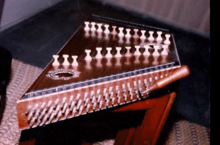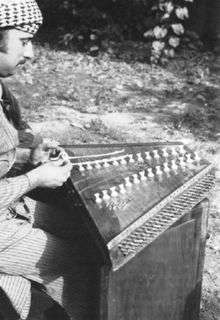Iraqi Santur (instrument)
|
The archetype of the instrument carried horizontally and struck with two sticks, found in iconographical documents in ancient Babylon (1600-911 BCE) and neo-Assyria (911-612 BCE). | |
| String instrument | |
|---|---|
| Classification | Struck |
| Related instruments | |
| Qanun | |


The santur (also santour, santoor ) (Arabic: سنطور) is a hammered dulcimer of Mesopotamian origin.[1] It is a trapezoid box zither with a walnut body and ninety two steel (or bronze) strings. The strings, tuned to the same pitch in groups of four, are struck with two wooden mallets called "midhrab". The tuning of these twenty-three sets of strings extends from the lower yakah (G) up to jawab jawab husayni (a). The bridges are called dama (chessmen in Iraqi Arabic) because they look like pawns. The name 'santur' is thought to be derived from the Greek psalterion which, itself, is the result of musical experiments by Phythagorus based on the 6,000-year-old bull-headed lyre discovered from excavations found in the ancient city of Ur ('Children's Book of Music' ISBN 978-0-7566-6734-4).[2] It is also thought that the name is derived from "Sant"- "Ur", meaning sound of Ur in Sumerian. It is native to Iraq, India, Pakistan, Turkey, Iran and Azerbaijan.
It is the main instrument used in the classical Maqam al-iraqi tradition along with the Iraqi spike fiddle joza. ('Music of the Arabs' ISBN 0-931340-88-8). The instrument was brought to Europe by the Arabs through North Africa and Spain during the Middle Ages and also to China where it was referred to as the "foreign qin".[3]
The Iraqi santur has, since its inception, been fully chromatic allowing for full maqam modulations. It uses 12 bridges of steel strings on both sides, and has three movable bridges: B half flat qaraar, E half flat and B half flat jawaab. The non-standard version of the Iraqi santur includes extra bridges so that there's no need to move those three bridges. However, playing it is a bit harder than playing the standard 12-bridge santur. ('Music of the Arabs' ISBN 0-931340-88-8) For a video demonstration, see Wesam al-Azzawy's video links in the sections below.
History
The santur was invented in Mesopotamia (modern-day Iraq, Kuwait, and parts of Iran, Syria and Turkey). This instrument was traded and traveled to different parts of the middle east and each country customized and designed their own versions to adapt to their musical scales and tunings. The original santur was made with tree bark, stones and stringed with goat intestines. The Mesopotamian santur is also the father of the harp, the Chinese yangqin, the harpsichord, the qanun, the cimbalom and the American and European hammered dulcimers. ('Music of the Arabs' ISBN 0-931340-88-8) .
Notable Iraqi santur players
- Abdallah Ali (1929–1998)
- Akram Al Iraqi
- Amir ElSaffar [5]
- Azhar Kubba
- Bahir Hashem Al Rajab
- Basil al-Jarrah
- Ghazi Mahsub al-Azzawi
- Hugi Salih Rahmain Pataw (1848–1933) [6]
- Hashim Al Rajab
- Hala Bassam
- Hammudi Ali al-Wardi
- Haj Hashim Muhammad Rajab al-Ubaydi (1921–2003)
- Hendrin Hikmat (1974-)
- Heskel Shmuli Ezra (1804–1894)
- Mohamed Abbas
- Muhammad Salih al-Santurchi (18th century)
- Muhammad Zaki Darwish al-Samarra'i (1955-) [7]
- Mustafa Abd al-Qadir Tawfiq
- Qasim Muhammad Abd (1969-)
- Rahmatallah Safa'i
- Sa'ad Abd al-Latif al-Ubaydi
- Sabah Hashim
- Saif Walid al-Ubaydi
- Salman Enwiya
- Salman Sha'ul Dawud Bassun (1900–1950)
- Sha'ul Dawud Bassun (19th century)
- Shummel Salih Shmuli (1837–1915)
- Wesam al-Azzawy (1960-) [8][9][10]
- Yusuf Badros Aslan (1844–1929)
- Yusuf Hugi Pataw (1886–1976) [6]
Sources
- Al-Hanafi, Jalal (1964). Al-Mughannūn al-Baghdādīyyūn wa al-Maqām al-ʻIrāqī. Baghdad: Wizarat al-Irshad.
- Touma, Habib Hassan (1996). The Music of the Arabs, trans. Laurie Schwartz. Portland, Oregon: Amadeus Press. ISBN 0-931340-88-8.
- Children's Book of Music' ISBN 978-0-7566-6734-4
References
- ↑ --- Rashid, Subhi Anwar (1989). Al-ʼĀlāt al-musīqīyya al-muṣāhiba lil-Maqām al-ʻIrāqī. Baghdad: Matbaʻat al-ʻUmmāl al-Markazīyya.
- ↑ Lyres of Ur
- ↑ --- Touma, Habib Hassan (1996). The Music of the Arabs. Amadeus Press.
- ↑ --- Al-Hanafi, Jalal (1964). Al-Mughannūn al-Baghdādīyyūn wa al-Maqām al-ʻIrāqī. Baghdad: Wizarat al-Irshad.
- ↑ http://amirelsaffar.com/
- 1 2 http://www.dangoor.com/72page41.html
- ↑ https://sites.google.com/site/santourmzdarwish/mohamedzakidarwish
- ↑ https://www.youtube.com/watch?v=9V7BlsQAud0
- ↑ https://www.youtube.com/watch?v=8teLR50E1Q8
- ↑ https://www.youtube.com/watch?v=rmOc7nUR4Hg
Further reading
- Duchesne-Guillemin, Marcelle (1980). "Sur la restitution de la musique hourrite". Revue de Musicologie 66, no. 1 (1980): 5–26.
- Duchesne-Guillemin, Marcelle (1984). A Hurrian Musical Score from Ugarit: The Discovery of Mesopotamian Music, Sources from the Ancient Near East, vol. 2, fasc. 2. Malibu, CA: Undena Publications. ISBN 0-89003-158-4
- Fink, Robert (1981). The Origin of Music: A Theory of the Universal Development of Music. Saskatoon: Greenwich-Meridian.
- Gütterbock, Hans (1970). "Musical Notation in Ugarit". Revue d'assyriologie et d'archéologie orientale 64, no. 1 (1970): 45–52.
- Kilmer, Anne Draffkorn (1971). The Discovery of an Ancient Mesopotamian Theory of Music. Proceedings of the American Philosophical Society 115:131–49.
- Kilmer, Anne Draffkorn (1974). "The Cult Song with Music from Ancient Ugarit: Another Interpretation". Revue d'Assyriologie 68:69–82.
- Kilmer, Anne Draffkorn (1997). "Musik, A: philologisch". Reallexikon der Assyriologie und vorderasiatischen Archäologie 8, edited by Dietz Otto Edzard, 463–82. Berlin: De Gruyter. ISBN 3-11-014809-9.
- Kilmer, Anne (2001). "Mesopotamia §8(ii)". The New Grove Dictionary of Music and Musicians, second edition, edited by Stanley Sadie and John Tyrrell. London: Macmillan Publishers.
- Kilmer, Anne Draffkorn, Richard L. Crocker, and Robert R. Brown (1976). Sounds from Silence: Recent Discoveries in Ancient Near Eastern Music. Berkeley: Bit Enki Publications, 1976. Includes LP record, Bit Enki Records BTNK 101, reissued [s.d.] as CD.
- Vitale, Raoul (1982). "La Musique suméro-accadienne: gamme et notation musicale". Ugarit-Forschungen 14 (1982): 241–63.
- Wellesz, Egon, ed. (1957). New Oxford History of Music Volume I: Ancient and Oriental Music. Oxford: Oxford University Press.
- West, M[artin]. L[itchfiel]. (1994). "The Babylonian Musical Notation and the Hurrian Melodic Texts". Music and Letters 75, no. 2 (May): 161–79.
- Wulstan, David (1968). "The Tuning of the Babylonian Harp". Iraq 30:215–28.
- Wulstan, David (1971). "The Earliest Musical Notation". Music and Letters 52 (1971): 365–82.
